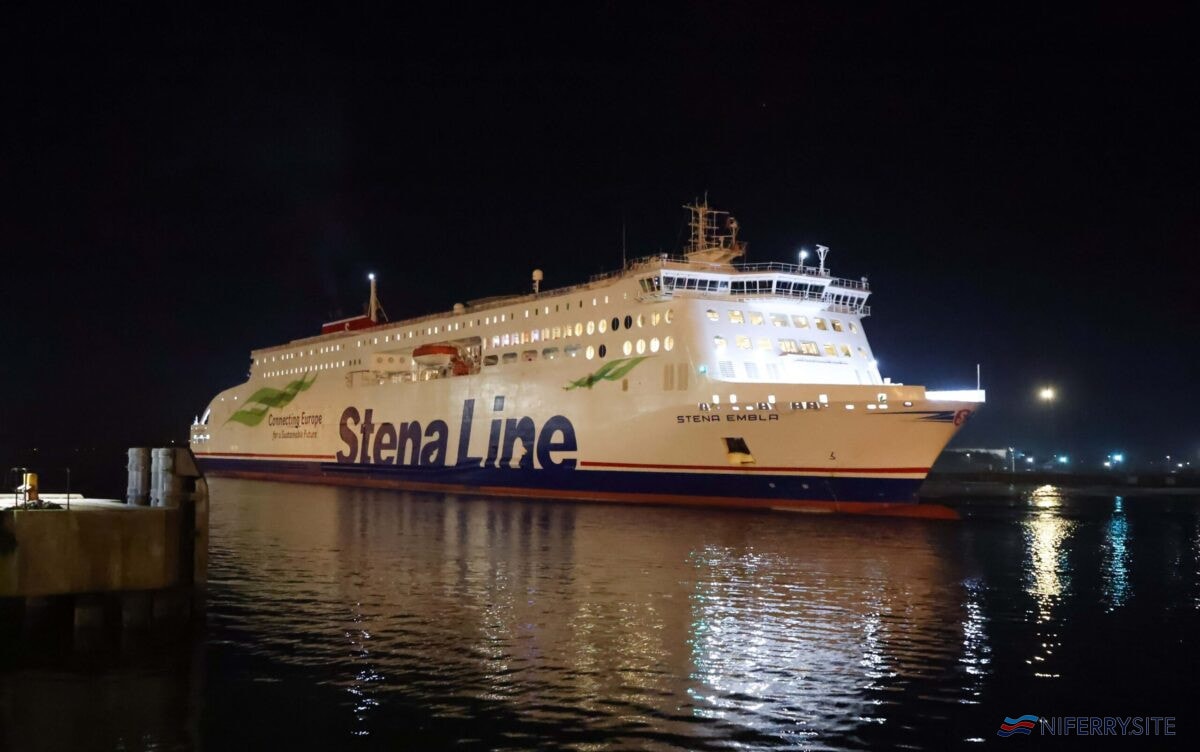Stena Line has revealed that the first of the two larger 240-metre E-flexers being built at China Merchants Jinling Shipbuilding (Weihai) has now moved into the drydock phase. She will be launched before summer and delivered a year later. Her sister will be delivered later in 2022. No names have yet been released for the new ships.
This larger version is 26 metres longer than the earlier E-Flexers, has a capacity for 3,600 lane metres of freight as opposed to 3,100 lane metres and passenger numbers are increased by 200 to 1,200. The pair are also prepared for shore power charging during port calls to reduce emissions. The electricity connection enables a conversion to electric hybrid in the future.
For a full overview of the differences in the E-Flexer class, check out this in-depth feature.
What route(s) might get these vessels?
Whilst Stena Line is being very tight-lipped about where this pair of new vessels may end up, we take a look at the Stena Line Ro-Pax routes and assess which might be the winner.
We have restricted ourselves to business considerations rather than port constraints as we all know innovative solutions have been found to adapting berths etc in the past.
Karlskrona – Gdynia. This busy route seems to go from strength to strength. A new ferry port is currently being constructed at Gdynia which could accommodate the 240m vessels and will include a shore power facility. The two new ships would offer a daily each way capacity of 7,200 lane metres, compared with the maximum of 6,128 lane metres offered by the current fleet of STENA SPIRIT, STENA VISION and STENA NORDICA. Replacing all three of the current vessels, this would allow the older generation ‘Spirit and ‘Vision to be retired from the fleet and the ‘Nordica to be moved to another route. This is our hot favourite!
Nynäshamn – Ventspils. This route is set to receive a major boost this year when the re-built STENA SCANDICA (ex STENA LAGAN) and STENA BALTICA (ex STENA MERSEY) replace the SCOTTISH VIKING and STENA FLAVIA. With capacity per ship already increased to 2,875 lane-metres, could a further increase happen? We wouldn’t rule it out!
Liepaja – Travemünde. This route is set for a 40% expansion in capacity this year when the URD and STENA GOTHICA is replaced by two Visentini-class ships. (Thought to be STENA FLAVIA and ETRETAT, but to date Stena Line has not confirmed the tonnage). It seems unlikely that the service would receive another major capacity increase so soon.
Goteborg – Frederikshavn. Last week, Stena Line announced a plan to launch two 3,000 lane-metre fossil free vessels on the Gothenburg-Frederikshavn route before 2030. This would appear to make it unlikely that this route will get new tonnage before this happens.

Gothenburg – Kiel. The STENA SCANDINAVICA and STENA GERMANICA, currently on this route, each have a capacity of 3,800 lane metres, making it unlikely that they’d be replaced by vessels of a smaller capacity.
Halmstad – Grenaa. Although this route holds a lot of potential, it seems impossible to think that this route, currently operated alone by the 1,265 lane-metre STENA NAUTICA, is a candidate for one or both of the new ships. But if the STENA NORDICA is released from the Polish service by the new E-flexers might we see that ship replacing or operating alongside the Nautica?
Trelleborg – Rostock. This route would seem unlikely given the rail-capability of the SKÅNE and MECKLENBURG VORPOMMERN. It’s also unclear if such a capacity increase is needed.
Harwich – Hoek van Holland. Given that the 5,566 lane-metre capacity of the STENA HOLLANDICA and STENA BRITANNICA dwarfs the 3,600 lane-metre capacity of these new E-flexers, we can safely rule out this route.
Rosslare – Cherbourg. After the Brexit transition period ended on 1 January 2021, there has been a massive increase in Ireland – EU Direct services. Stena Line temporarily moved the E-flexer STENA EMBLA to the Rosslare – Cherbourg route, followed by the STENA ESTRID for an ongoing period of a duration to be confirmed. Long-term demand for these direct routes is expected to subside as the supply chain adjusts to the new Brexit controls. It seems unlikely that this route would need one or both of these two 240-metre vessels.
Rosslare – Fishguard. Even without the current post-Brexit traffic drops, a replacement of this size would never be needed for the STENA EUROPE.
Dublin – Holyhead. Replacing the 3,400 lane metre STENA ADVENTURER and 3,100 lane-metre E-Flexer STENA ESTRID with two identical 3,600 E-flexers would probably be an attractive option for Stena Line in normal circumstances. However, given the uncertainty of Ireland – Great Britain traffic flows in a Post-Brexit era, this may be less likely. However, if traffic returns to normal levels, might this be an option? We wouldn’t rule it out.

Belfast – Birkenhead. This route has already received two E-flexers, STENA EDDA and STENA EMBLA, even though to date the pair have yet to operate together. Whilst they represent a big capacity increase over the tonnage they have replaced, the STENA LAGAN and STENA MERSEY, could post-Brexit traffic flows see such demand for GB – Northern Ireland capacity, that this route will receive the larger E-flexers? This seems unlikely, but not impossible.
Belfast – Cairnryan. Athough a solid-performer for many years, it would seem unlikely that such large vessels would be needed for the shortest and most frequent route on the Stena Line network. STENA SUPERFAST VII and STENA SUPERFAST VIII have a capacity of 1,924 lane metres, replacing with ships of 3,600 lane metres would seem excessive.
Our Verdict. In these unpredictable times of Covid-19, Brexit and an ever changing ferry industry, it’s difficult to say anything for sure but our bet for the larger E-flexers is that they will go to Karlskrona – Gdynia. However, we also wouldn’t rule out that other routes might have a chance too such as Dublin – Holyhead and Nynäshamn – Ventspils.
